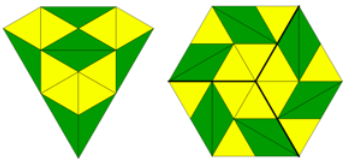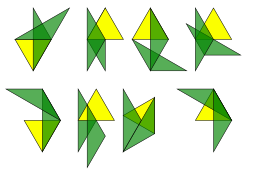Skip over navigation






Or search by topic
Number and algebra
Geometry and measure
Probability and statistics
Working mathematically
Advanced mathematics
For younger learners
Triangle Shapes
Age 5 to 11
Challenge Level 






Here are two triangles. We're going to see what shapes we can get by using many of them.
You will need to print off this sheet of triangles to cut out and use.
You might try putting them together like this:

Try making that or something similar.
Sometimes you can make "jewel-like" shapes:

See what "jewels" you can make.
You might make the triangles from different materials, or use an overhead projector transparency so that they are a bit transparent, then you can overlap them:

When you do that, you might try to see what shapes you've made at the overlap.
Maybe you could experiment further with this idea and create pictures like these:

Please do send in pictures of the shapes you make, whether they include overlaps or not.
Tell us what you notice about the shapes you've made.
You may also like
Baked Bean Cans
Is there a best way to stack cans? What do different supermarkets do? How high can you safely stack the cans?

